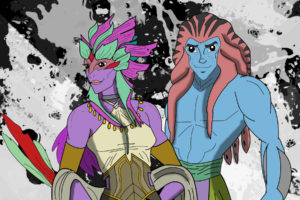Merfolk (mehr-fohk)
Merfolk or “Merpeople” were amphibious people with skin in a variety of designs and vivid colors. Out of all the people in Fabella, their appearance varied the most. No two merpeople were the same. It wasn’t unusual at all for them to have pink, blue, orange, or even purple skin combined with tentacles for hair or dorsal fins. Contrary to popular belief, merfolk did not have a fish tail bottom half. They were bipedal people whose webbed feet and hands aided them greatly underwater. Mermaids had scales which grew up around the breasts. The lung capacity for merfolk was about twice that of a regular human being.
Full-blooded merpeople could live out of the water as long as they remained soaking wet. If their bodies became dry, they would go into respiratory shock. Full blooded numbers became more rare as time went on and merfolk began mating with other people. Merfolk with the blood of any foreign person in their ancestral line less than three generations deep were referred to as “Jumble-bloods.” Jumble-bloods retained enough moisture in their bodies that they were able to survive on land for one day and completely submerged for the same amount of time. In most cases, a simple shower or soak in a tank was enough to moisten their skin.
Culture
Language
The identifying language of merfolk was called “Subish.” It was only spoken by 25% – 30% of the world’s population. Formed by a complicated system of fin movements, clicks, and hand gestures only merfolk were capable of performing, Subish was a solely physical sign language which could not be written. The language was made a political issue by many countries’ policies restricting its use in those regions; however, this did not stop the teaching, speaking and cultivation of this increasingly vibrant language.
Fashion
Ornaments such as necklaces and bracelets were an important aspect of merfolk traditions. Mermaids usually wore a brooch passed down through the mothers in their family. In ancient times, mermaids wore a vast collection of jewelry to model pieces created by their husbands for trading. It was common for mermaids to perform dances and sing folk songs at different trading events. These songs and dances survived through the years and merfolk were known for being a musical people. The tradition of mothers singing lullabies to their children actually began with merpeople.
Matrilineality
Many but not all of the merfolk practiced their traditional matrilineal customs, living in their traditional extended family households. The traditional merfolk economic and political organization was based on matrilineal lineages, which were the basis of inheritance and succession. A lineage was defined as all those related by matrilineal descent from a particular ancestress. Several lineages were grouped into a political unit headed by a council of elders, each of whom was the elected head of a lineage – which itself included multiple extended-family households. Mermaids were thus responsible for leading the family in socio-politcal matters and speaking for the household. This tradition continued throughout history with eldest mermaid mother of the family line holding such enormous power for their lineage that they could influence entire elections.
Population
Merfolk kept their true numbers hidden from the rest of the world, but consistently claimed they represented the largest population distribution in Fabella. These claims were never verified and the World Court agreed to list them first on the condition that an asterisk be included dictating that no official declaration could be made due to lack of census paperwork.

